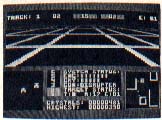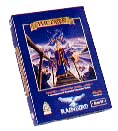Games Galore for 8-bit
Pawn, Dropzone, Tomahawk, Solar Star, Stationfall, Lurking Horror
DROPZONE, SOLAR STAR
Dropzone is a scrolling shoot-out in Defender style. You control a well-armed spaceman flying back and forth over a planet surface. Below are structures, mountains and small, moving crystals which are the inhabitants of the planet. A radar screen shows the location of any approaching enemies.
Suddenly, aliens appear from the air and you must defend the planet by blasting invaders with your ray gun, while at the same time picking up the inhabitants and conveying them to a safe structure, one at a time.

There are a multitude of aliens, of many different types. Some will try to pick up the planet's inhabitants, turning them into fast deadly mutants which come for you unerringly. Other aliens unleash bolts of energy, killing off the inhabitants, while still others release a series of tracking missiles when you destroy them. These missiles are very hard to hit and will chase you until either you get them or they get you.
Contact with an alien or a missile will cause you to explode in a spectacular blast. You have three lives, and get a new one with each wave of aliens you survive. In addition to your ray gun, tapping the space bar will unleash a bomb which destroys everything on the screen, and other keyboard commands will temporarily make you invisible to the enemy. Each wave you survive also adds one to your store of special bombs and more time to your "cloak."
Dropzoone is very tough. The aliens come fast, and you must keep a sharp eye on the radar screen. The screen can get very crowded with things trying to kill you. You are also a pretty big target for the aliens to hit. The graphics are very good and the sound is full and effective.

In Solar Star, you pilot a fighter through a power grid, trying to recover the crystals which Earth needs for energy. The grid is a maze, and the walls come up with startling rapidity, so you need to be careful and keep an eye on your scanners.
Running into a wall or into a white, moving disrupter costs you energy. When all the energy is gone the game is over. If you manage to shoot a disrupter the required number of times (this increases in the higher levels), it turns into a moving green crystal. You must then chase it down and run over it to capture it. If you manage to capture 10, you can try to blast the central controller for that section of the grid.
The central controller is surrounded by a revolving wall of energy which has a small hole in it. You must fire through this hole. If you are successful in destroying the controller, then you move on to the next, tougher wave of grids.
The graphics of Solar Star are only fair, with a rather coarse blue grid being the main view out of the cockpit. This is also a really tough game. Avoiding disrupters turns out to be quite a trick, and all too soon your energy is drained by collisions and the game is over. It will challenge arcaders with even the most seasoned reflexes.- DAVID PLOTKIN
$24.95 each, 48K disk. MicroDaft, 19 Harbor Drive, Lake Hopatcong, NJ 07849. (201) 663-0202.

THE PAWN
The 8-bit version of the early ST adventure hit, The Pawn, features stunning graphics and the capability of understanding full-sentence commands. Pawn graphics are actually the best I've seen for the 8-bit. Caverns and bridges seem real enough to touch and you can almost feel the cold as you approach the ice tower. At any time, the graphics can be turned off to speed up the game, or turned back on.
In The Pawn, commands can be combined to form creative sentences, such as, "Sit down at the table, pick up the fork and eat the shoe." Communication is almost conversational. Characters are cryptic, mysterious, even dangerous, but talking with them is vital. Only a specific character might be able to provide the knowledge or object you need.
The game package contains two disks which you should copy before playing. Instructions include a booklet called "A Tale of Kerovnia" which contains hints for some of the stickier puzzles as well as giving you the flavor of the adventure plus a general idea of the theme. When you're stuck, you can consult the coded clue section in the back of the booklet.
The Pawn's copy-protection is a password system that interferes with the illusion of the game. Occasionally you'll have to type a word from "A Tale of Kerovnia" in order to continue playing--three strikes and you're out.
Aside from its superior graphics, The Pawn is actually much like other adventure games. But it's still fun and a step ahead of the rest.--JOHN MANOR
$39.95, 48K disk. Firebird Licensees Inc., 71 Franklin Turnpike, Waldwick, NJ 07463. (201) 444-5700.
TOMAHAWK
Tomahawk is a sensational helicopter battle simulator featuring 3-D realtime graphics. You get to fly the AH-64A Apache attack helicopter, an awesome fighting machine armed with guided missile, rockets and twin machine guns. You can choose from four missions at four difficulty levels.
The missions consist of various strategic strikes against enemies attacking Allied positions. You can switch to a map view at any time and see the locations of enemy forces. The map is divided into a grid, and each section has eight enemy targets, including tanks, anti-aircraft guns and choppers. Careful strategy is needed to defeat the enemy without running out of fuel and ammunition.
The AH-64A is very well equipped with systems to ensure survivability. Besides engine instruments, there is target location radar, weapons system status, damage monitors, turn and bank indicators, an airspeed indicator, and an altimeter. The target radar can show you the heading and distance to targets, beacons (for navigation) and the nearest friendly heliport. A miniature screen will lock onto targets, identify them and show the decreasing range as you close in on them. In the upper levels, these targets are busily firing at you.
Controlling the helicopter takes some getting used to. Unlike a fixed-wing airplane, a helicopter has a "collective" stick which controls how much lift the rotors are providing. A helicopter can hover, and even turn while standing still! These unusual flight characteristics take some getting used to, but the excellent manual not only gives background material, but step-by-step instructions on how to take off and land, hover, and fly this nimble aircraft.
The graphics view is out-the-cockpit in smooth, wireframe 3-D. Many landmarks-buildings, trees, bushes--can be seen on the ground below. Night and cloud-cover missions are available as well as the standard daylight/clear combat conditions!
Tomahawk is a tough game to play because you are attempting to shoot at a target which is on the ground. So you have the tendency to fly into the ground when diving on the target. The trick is not to be too zealous and break off the attack while you can still pull up. If you do crash, the windshield cracks and you wind up back at the base, if you have remaining choppers (you start with three).
The joystick banks, climbs and descends, while the keyboard controls the rudder, throttle, collective, weapons system choice and target radar choice. This is not as bad as it sounds, since most of the systems controlled by the keyboard are "set and forget" during combat. You fly the Apache with a joystick plugged into port 2. Although not noted in the documentation, a joystick plugged into port 1 can also control the collective, so you don't have to use the keyboard for that.
Overall, I was quite impressed by the smooth graphics, playability, and ease of control of Tomahawk. The missions were somewhat simplistic, but still fun to play.-DAVID PLOTKIN
$29.95, 48K disk. Intellicreations (Datasoft), 19808 Nordhoff Place, Chatsworth, CA 91311. (818) 886-5922.
LURKING HORROR, STATIONFALL
In Infocom's first horror-fiction adventure, it's all too easy to be pulled into the game play--which can keep you up at night, looking nervously over your shoulder. In Lurking Horror you're a student at the George Underwood Edwards Institute of Technology-sort of a cross between MIT and Miskatonic University (for you H.P. Lovecraft readers).
In the beginning, you're at the computer center the night before a major paper is due. Trapped inside the buildings by a raging blizzard, you settle down to finish your paper with an overzealous computer hacker as your only (human) companion. Slowly but inexorably you'll head toward confrontation with nightmarish forces that could cost you both your life and your soul.
Your searches will take you from the tallest buildings down into the bowels of long abandoned tunnels and hidden rooms which lie festering under the campus. Without revealing too much, suffice it to say that you'll encounter a malevolent maintenance man, have a terminal religious experience, practice your culinary skills and discourse with a doctor of demonology--until all hell breaks loose.
You can play several different story branches, rather than having to go directly from start to finish. Thus, if a puzzle stumps you, you can go off on a different tangent and continue-- often finding something to help with the original puzzle. Though there's far more searching and puzzle-solving than conversing with other characters, it's often more helpful to show them something than to speak and provoke a reaction.
The first half of the adventure is fairly easy, but the puzzles become more complex and interesting toward the end. The story itself is tight and well-crafted. It's easy --to easy--to visualize the scenes while cautiously prowling through moldering sub-basements. Overall, I enjoyed the game and would recommend it, particularly for someone new to text adventures.
Stationfall, Infocom's first text adventure sequel, continues the saga begun in Planetfall, a fast-moving cross between Larry Niven and National Lampoon that gave us very memorable Floyd the Droid--the endearing Gomer Pile of robots. In Stationfall, we return to the future time of the Third Galactic Union. Our hero has found fleeting fame, a promotion to Lieutenant First Class in the Stellar Patrol, and the numbing realization of facing nothing more than shuffling paperwork for the rest of his career--a case in point being an assignment to pick up a multi-ton load of forms at a local space station printing press.
Strange things happen as soon as you dock at the space station. The place is a virtual ghost town. What has happened here? What about the alien space craft, its dead pilot and mysterious cargo that you find? As you continue probing, you recognize signs of an unknown malevolent force that has overtaken the space station.
Fortunately, at your side is Floyd the Droid, rebuilt from circuit board heaven and ready to boogie. Between bouts of finder-seeker and paddleball, your little buddy is along to help solve the mystery and (maybe) save your bacon again. You will also encounter Plato (the only surviving space station robot), an ostrich, an abandoned Arcturan balloon creature and an automated welder that seems to disagree with your continued existence.
Stationfall has plenty of puzzles to solve and rooms to explore. The puzzles are good: hard enough to make you think, but logical, at least in hindsight.
This sequel is, if anything, better than the original story. The plot line is crisp and full of humor--to go along with the straight science fiction. The mood, pacing and characters, right down to the scatology are a faithful re-creation of the original.- JIM PIERSON-PERRY
(The ST versions of these text adventures were reviewed in Antic, February 1988.--ANTIC ED)
$34.95 each, 48K disk. Infocom, 125 CambridgePark Drive, Cambridge, MA 02140. (617) 492-6000.